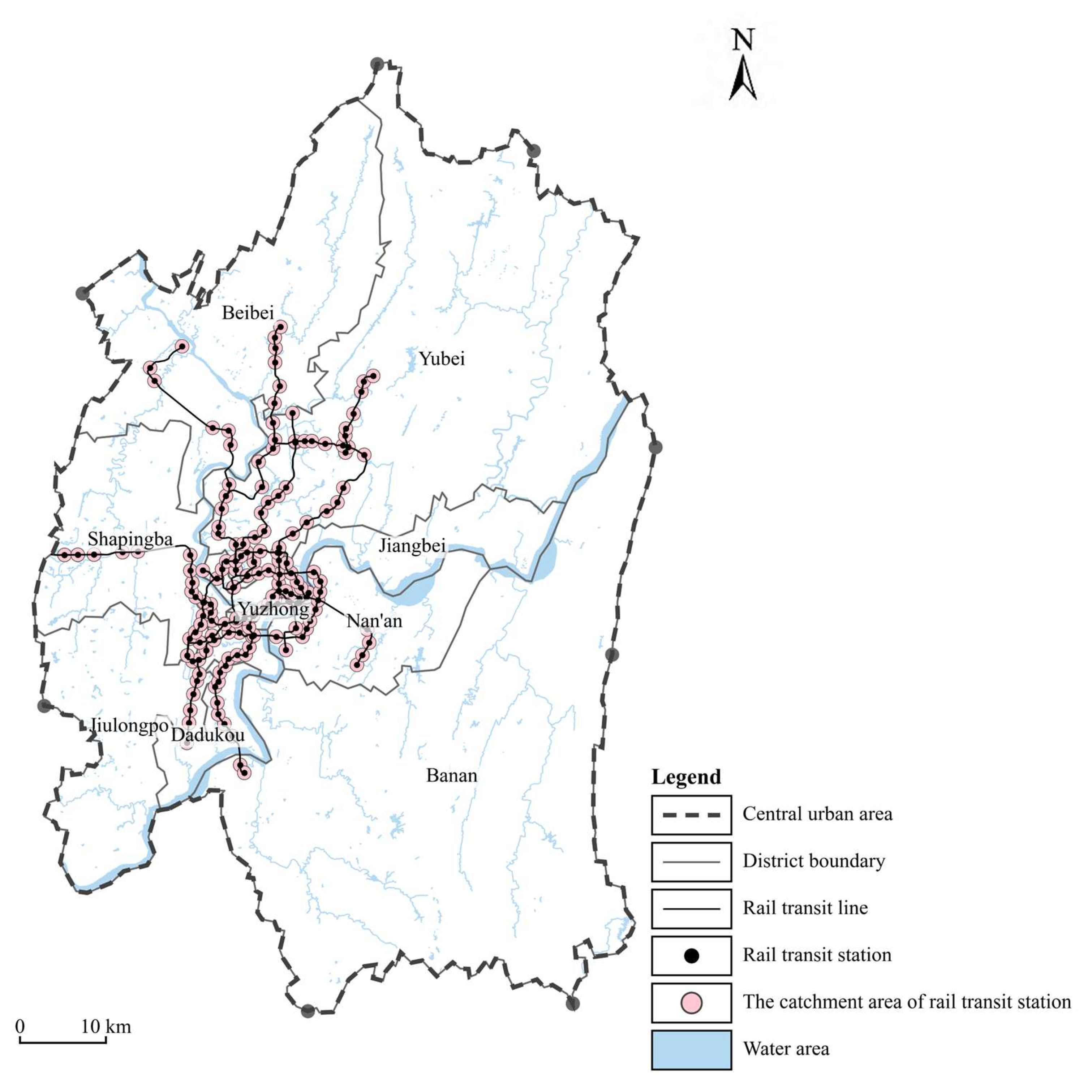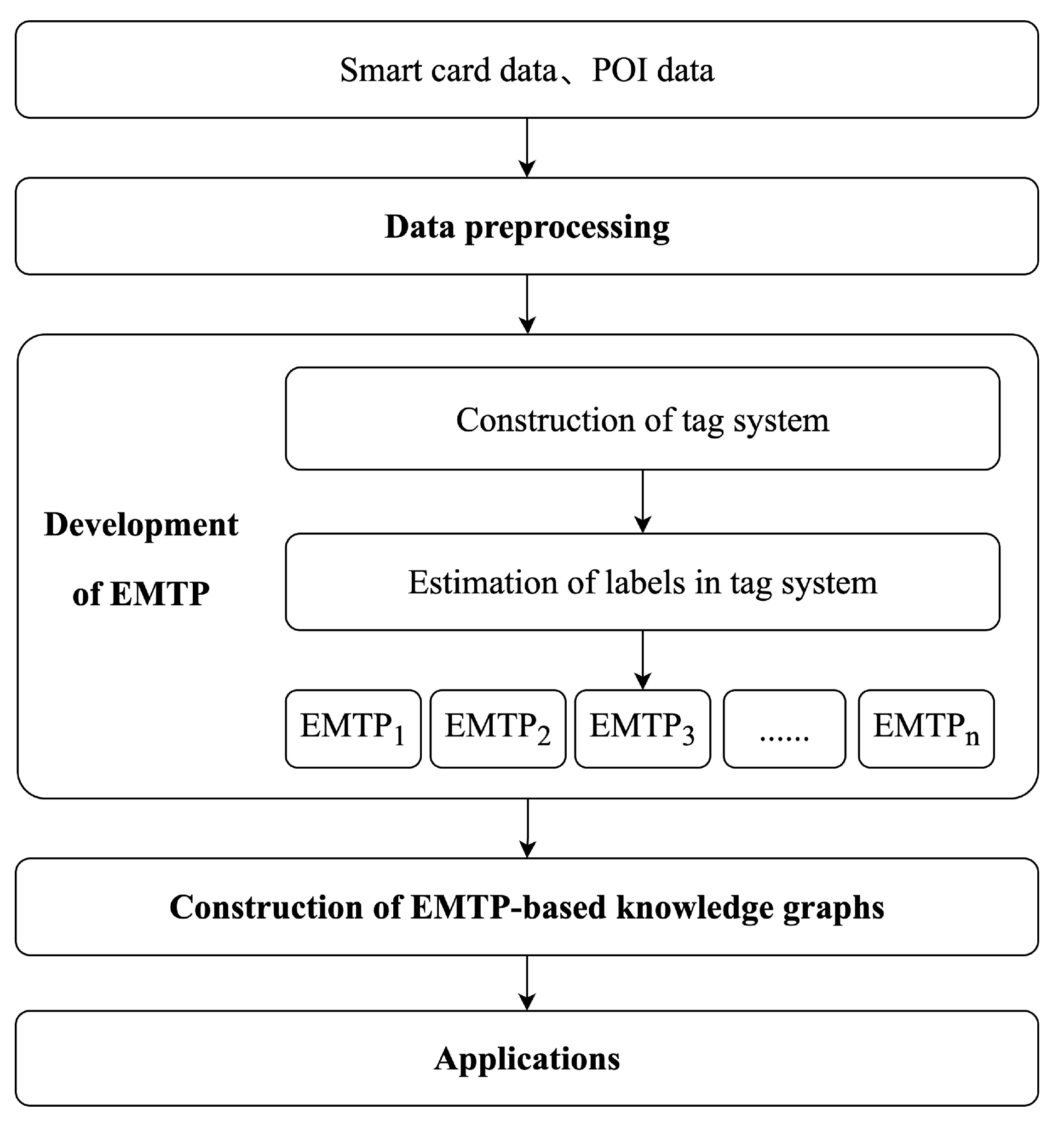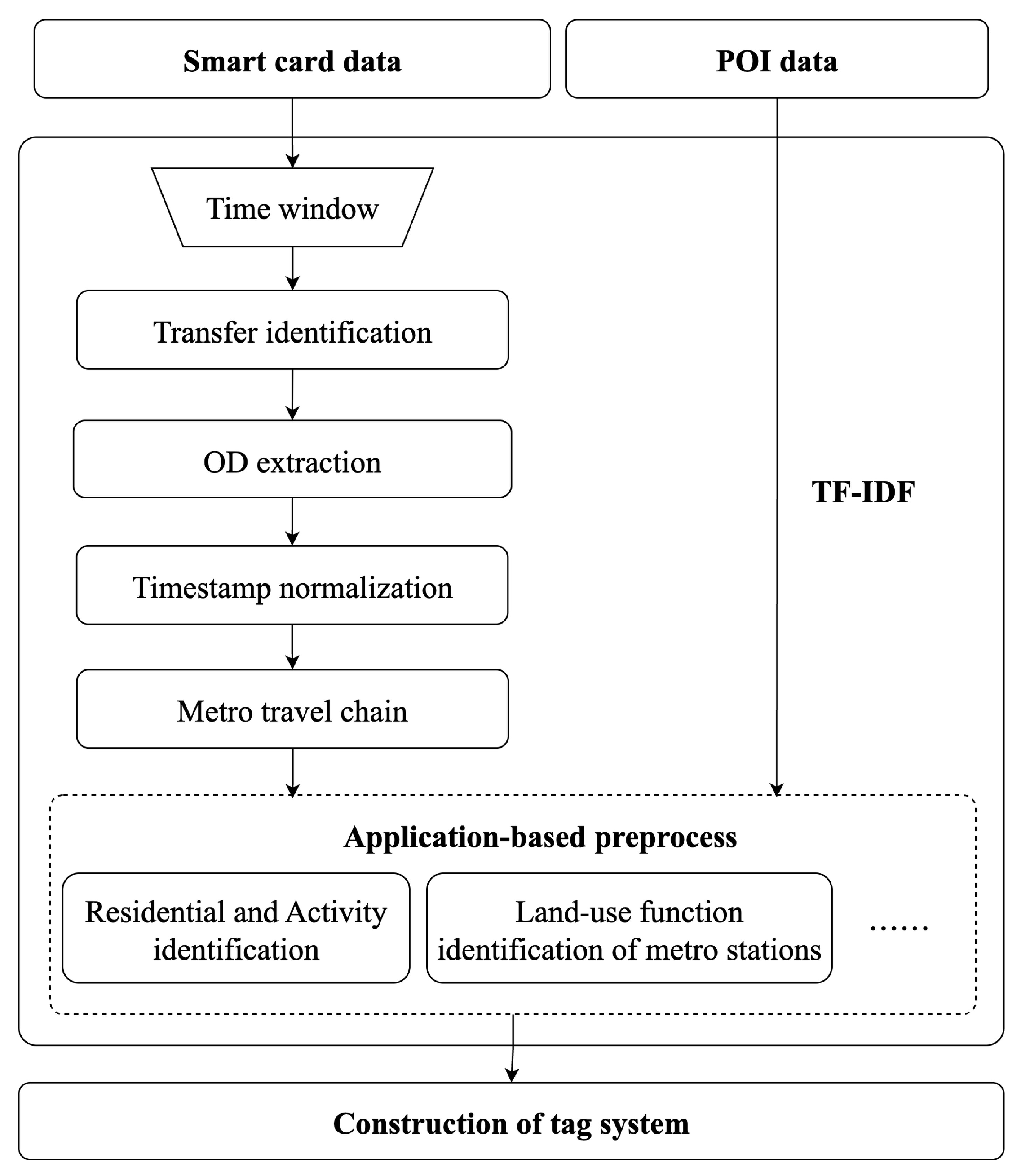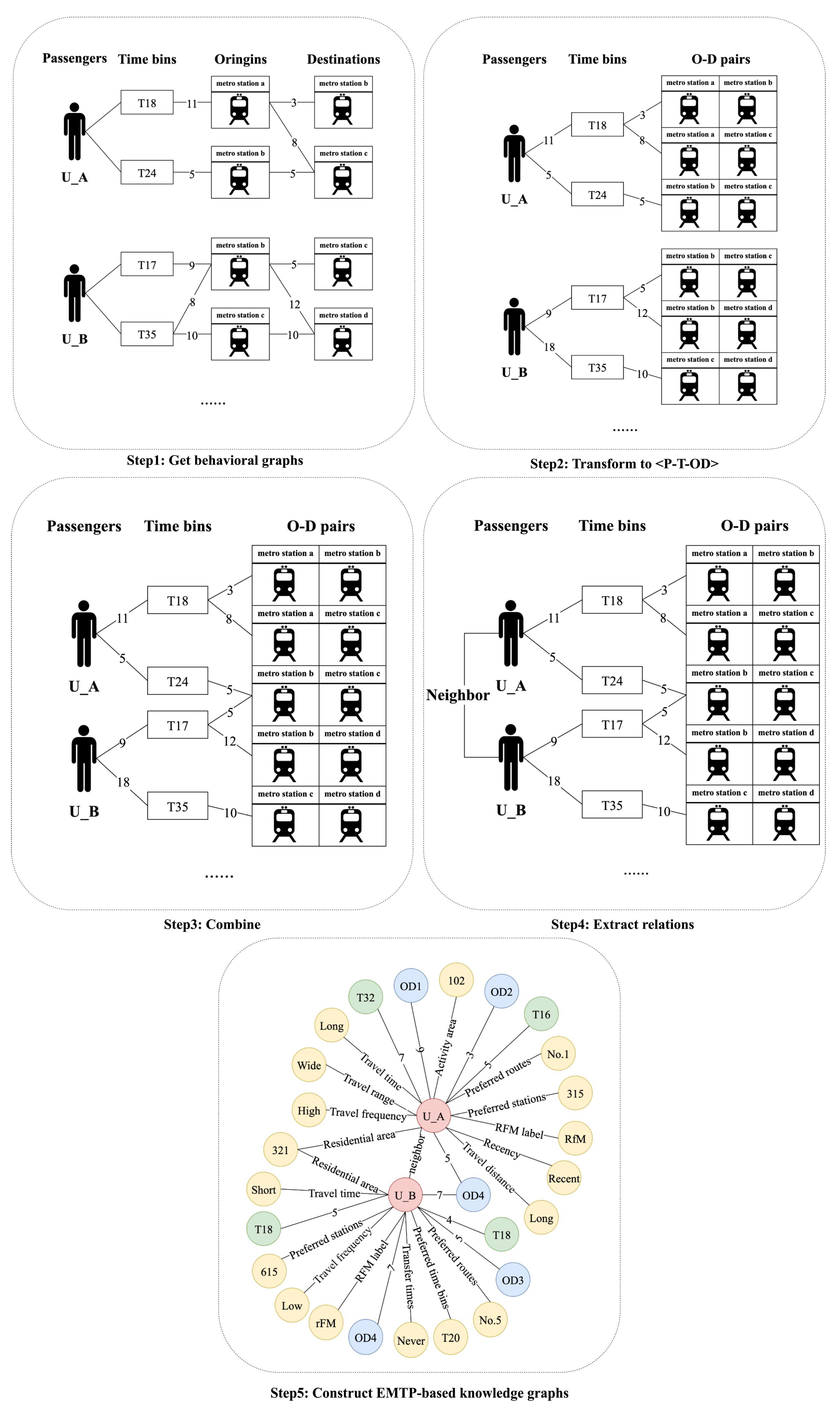Knowledge Graph-Enabled Prediction of the Elderly’s Activity Types at Metro Trip Destinations
Abstract
1. Introduction
- (1)
- This study proposes a data-driven framework to develop an elderly metro travel profile (EMTP), including data preprocessing and tag system construction for structured semantic representation of travel characteristics.
- (2)
- This study constructs an elderly metro travel knowledge graph (EMTKG) that integrates labels in profiles with origin-destination (OD) behavior graphs, forming entities (users, time bins, OD pairs, labels) and relations to support semantic reasoning.
- (3)
- This study transforms the destination activity types prediction task into a knowledge graph completion problem and introduces the Temporal and Non-Temporal ComplEx (TNTComplEx) model, which embeds entities and relations within the graph into a continuous low-dimensional vector space and captures temporal dynamics for precise activity types prediction. The plausibility of facts within the knowledge graph is evaluated by a scoring function.
- (4)
- Validated on the elderly metro travel dataset from Chongqing, China, the proposed model achieves a superior performance than the advanced baselines in terms of accuracy and efficiency. Additionally, the ablation experiment results also demonstrate the effectiveness of each component.
2. Literature Review
2.1. Complex Travel Behaviors of the Elderly
2.2. User Profiling Is Becoming Prominent
2.3. New Technologies Bring Evolution
3. Data Description
3.1. Study Area
3.2. Data Sources
4. Methodology
4.1. Workflow Overview
4.2. Development of Elderly Metro Travel Profiles
4.2.1. Data Preprocessing
| Algorithm 1. Residential and Activity Area Identification. |
| Input: Smart card record for each elderly passenger ; The number of passengers |
| Method: |
| 1. for = 0 to do |
| 2. Extract the first record of each day in to form |
| 3. Extract the last record of each day in to form |
| 4. if the most frequent origin station in exceeds 1/3 of the total do |
| 5. = |
| 6. end if |
| 7. if the most frequent destination station in exceeds 1/3 of the total do |
| 8. = |
| 9. end if |
| 10. end for |
| Output: The metro stations of residential areas and activity areas |
4.2.2. Development of Tag System
- Construction of tag system for EMTP
- 2.
- Estimation methods for labels in tag system for EMTP
4.3. Construction of EMTP-Based Knowledge Graphs
4.4. Applications of EMTP-Based Knowledge Graphs
| Algorithm 2: Training algorithm for EMTKG. |
| Input: Training set ; EMTP tag set ; ; . |
| Initialize: initialize embeddings , , , , . |
| Method: |
| 1. for do |
| 2. |
| 3. while do |
| 4. Sample a mini-batch |
| 5. |
| 6. 0 |
| 7. for each do |
| 8. |
| 9. element-wise product of embeddings of tags in |
| 10. |
| 11. |
| 12. Construct negative sample set |
| 13. for each in negatives do |
| 14. |
| 15. |
| 16. end for |
| 17. |
| 18. end for |
| 19. Update parameters of embeddings w.r.t the gradients using |
| 20. end while |
| 21. end for |
| Output: embeddings , , , , . |
| Algorithm 3: Predicting future movement based on EMTKG. |
| Input: The set of target time , EMTP tag set , the embeddings of all entities including , , , , . |
| Method: |
| 1. for do |
| 2. |
| 3. element-wise product of embeddings of tags in |
| 4. embeddings of |
| 5. |
| 6. for do |
| 7. |
| 8. end for |
| 9. |
| 10. end for |
| Output:, where each presents the POI predicted to be visited by at time . |
5. Experiment
5.1. Problem Statement
5.2. Compared Algorithms
- (1)
- LSTM: Long short-term memory (LSTM) is a classical Recurrent neural network (RNN) architecture effective at capturing temporal dynamics through gating mechanisms, but limited in modeling spatial dependence [56].
- (2)
- DeepMove: DeepMove incorporates an attention mechanism into RNN and integrates spatiotemporal, semantic, and contextual information to capture complex spatiotemporal dependences in human mobility patterns [57].
- (3)
- APHMP: Attention-based personalized human mobility prediction (APHMP) is a trajectory prediction model that combines attention mechanisms with hierarchical spatial modeling. To mitigate potential privacy concerns, this study removes its original decentralized learning module [58].
- (4)
- ARNN: Attentional recurrent neural network (ARNN) introduces an attention mechanism into RNN and leverages semantic information extracted from knowledge graphs to enhance the understanding of semantic relations between locations and spatial context. In this study, a lightweight knowledge graph is constructed using label information to support this model [59].
5.3. Evaluation Metrics
5.4. Experimental Setting
5.5. Experimental Results
5.5.1. Overall Performance
5.5.2. Ablation Experiments
5.5.3. Impact of Temporal Dynamics
5.5.4. Computational Efficiency
6. Discussion and Conclusions
Author Contributions
Funding
Data Availability Statement
Acknowledgments
Conflicts of Interest
Abbreviations
| POI | points of interest |
| OD | origin-destination |
| EMTP | elderly metro travel profile |
| EMTKG | elderly metro travel knowledge graph |
| TNTComplEx | Temporal and Non-Temporal ComplEx |
| API | application programming interface |
| TF-IDF | term frequency-inverse document frequency |
| MRR | mean reciprocal rank |
| Acc@k | accuracy at top-k |
| GPU | graphics processing unit |
References
- United Nations Department of Economic and Social Affairs. World Population Prospects 2024: Summary of Results; UN DESA/POP/2024/TR/NO.9; United Nations: New York, NY, USA, 2024. [Google Scholar]
- State Council of China. National Economy Witnessed Steady Progress Amidst Stability with Major Development Targets Achieved Successfully in 2024. Available online: https://www.stats.gov.cn/english/PressRelease/202501/t20250117_1958330.html (accessed on 31 July 2025).
- Ravensbergen, L.; Van Liefferinge, M.; Isabella, J.; Merrina, Z.; El-Geneidy, A. Accessibility by public transport for older adults: A systematic review. J. Transp. Geogr. 2022, 103, 103408. [Google Scholar] [CrossRef]
- Ravensbergen, L.; Newbold, K.B.; Ganann, R.; Sinding, C. ‘Mobility work’: Older adults’ experiences using public transportation. J. Transp. Geogr. 2021, 97, 103221. [Google Scholar] [CrossRef]
- Acharya Samadarshi, S.C.; Taechaboonsermsak, P.; Tipayamongkholgul, M.; Yodmai, K. Quality of life and associated factors amongst older adults in a remote community, Nepal. J. Health Res. 2022, 36, 56–67. [Google Scholar] [CrossRef]
- Maresova, P.; Krejcar, O.; Maskuriy, R.; Bakar, N.A.A.; Selamat, A.; Truhlarova, Z.; Vítkova, L. Challenges and opportunity in mobility among older adults–key determinant identification. BMC Geriatr. 2023, 23, 447. [Google Scholar] [CrossRef]
- Kim, S. Effects of perceived accessibility to living infrastructure on positive feelings among older adults. Behav. Sci. 2024, 14, 1025. [Google Scholar] [CrossRef]
- Maresova, P.; Komarkova, L.; Truhlarova, Z.; Tomsone, S.; Joukl, M.; Vítková, L.; Horák, J. Influence of mobility and technological factors of mobility on the quality of life of older adults: An empirical study focused on mobility as a mediator. J. Transp. Health 2025, 42, 102015. [Google Scholar] [CrossRef]
- Sun, H.; Jing, P.; Wang, B.; Ye, J.; Du, W.; Luo, P. More travel, more well-being of older adults? A longitudinal cohort study in China. J. Transp. Health 2023, 32, 101672. [Google Scholar] [CrossRef]
- State Council of China. Railway Offers Discounts for Senior Riders. Available online: https://english.www.gov.cn/news/202503/18/content_WS67d8cea9c6d0868f4e8f0ec0.html (accessed on 31 July 2025).
- Schouten, A.; Wachs, M.; Blumenberg, E.A. Cohort analysis of driving cessation and limitation among older adults. Transportation 2022, 49, 841–865. [Google Scholar] [CrossRef]
- Remillard, E.T.; Campbell, M.L.; Koon, L.M.; Rogers, W.A. Transportation challenges for persons aging with mobility disability: Qualitative insights and policy implications. Disabil. Health J. 2022, 15, 101209. [Google Scholar] [CrossRef]
- Daganzo, C.F.; Ouyang, Y. A general model of demand-responsive transportation services: From taxi to ridesharing to dial-a-ride. Transp. Res. Part B Methodol. 2019, 126, 213–224. [Google Scholar] [CrossRef]
- Liang, Y.; Ding, F.; Huang, G.; Zhao, Z. Deep trip generation with graph neural networks for bike sharing system expansion. Transp. Res. Part C Emerg. Technol. 2023, 154, 104241. [Google Scholar] [CrossRef]
- Guo, R.; Guan, W.; Vallati, M.; Zhang, W. Modular autonomous electric vehicle scheduling for customized on-demand bus services. IEEE Trans. Intell. Transp. Syst. 2023, 24, 10055–10066. [Google Scholar] [CrossRef]
- Shi, Z.; Zhou, C.; Cheng, L.; He, M.; Liu, Y. Examining spatial variations in walking activity among older adults considering the impact of topographical characteristics. Transp. Res. Rec. 2025, 2679, 458–475. [Google Scholar] [CrossRef]
- Buehler, R.; Pucher, J.; Wittwer, R.; Gerike, R. Travel behavior of older adults in the USA, 2001–2017. Travel Behav. Soc. 2024, 36, 100783. [Google Scholar] [CrossRef]
- Zhang, Y.; Yao, E. Exploring elderly people’s daily time-use patterns in the living environment of Beijing, China. Cities 2022, 129, 103838. [Google Scholar] [CrossRef]
- Ozbilen, B.; Akar, G.; White, K.; Dabelko-Schoeny, H.; Cao, Q. Analysing the travel behaviour of older adults: What are the determinants of sustainable mobility? Ageing Soc. 2024, 44, 1964–1992. [Google Scholar] [CrossRef]
- Kang, S.; Cole, S.; Choe, Y. The influence of future time perspective on older adults’ travel intention. Curr. Issues Tour. 2023, 26, 1254–1267. [Google Scholar] [CrossRef]
- Hansmann, K.J.; Gangnon, R.; McAndrews, C.; Robert, S. Social and Environmental Characteristics Associated With Older Drivers’ Use of Non-driving Transportation Modes. J. Aging Health 2024, 08982643241258901. [Google Scholar] [CrossRef]
- Villena-Sanchez, J.; Boschmann, E.E.; Avila-Forcada, S. Daily travel behaviors and transport mode choice of older adults in Mexico City. J. Transp. Geogr. 2022, 104, 103445. [Google Scholar] [CrossRef]
- Klein, S.; Brondeel, R.; Chaix, B.; Klein, O.; Thierry, B.; Kestens, Y.; Perchoux, C. What triggers selective daily mobility among older adults? A study comparing trip and environmental characteristics between observed path and shortest path. Health Place 2023, 79, 102730. [Google Scholar] [CrossRef]
- Cheng, L.; Shi, K.; De Vos, J.; Cao, M.; Witlox, F. Examining the spatially heterogeneous effects of the built environment on walking among older adults. Transp. Policy 2021, 100, 21–30. [Google Scholar] [CrossRef]
- Xue, J.; Si, B.; Cui, H.; Zhu, S. Research on hierarchical clustering method of urban rail transit passengers based on individual portrait. J. Phys. Conf. Ser. 2021, 1883, 012039. [Google Scholar] [CrossRef]
- Liu, Y.; Zhou, Z.; Li, Y.; Jin, D. Urban knowledge graph aided mobile user profiling. ACM Trans. Knowl. Discov. Data 2024, 18, 1–30. [Google Scholar] [CrossRef]
- Yaakub, N.; Napiah, M. Public bus passenger demographic and travel characteristics: A study of public bus passenger profile in Kota Bharu, Kelantan. In Proceedings of the 2011 National Postgraduate Conference, Perak, Malaysia, 19–20 September 2011; IEEE: Piscataway, NJ, USA, 2011; pp. 1–6. [Google Scholar] [CrossRef]
- De Ona, J.; de Oña, R.; Diez-Mesa, F.; Eboli, L.; Mazzulla, G. A composite index for evaluating transit service quality across different user profiles. J. Public Transp. 2016, 19, 128–153. [Google Scholar] [CrossRef]
- Liu, S.; Jiang, H. Personalized route recommendation for ride-hailing with deep inverse reinforcement learning and real-time traffic conditions. Transp. Res. Part E Logist. Transp. Rev. 2022, 164, 102780. [Google Scholar] [CrossRef]
- Wang, P.; Liu, K.; Jiang, L.; Li, X.; Fu, Y. Incremental mobile user profiling: Reinforcement learning with spatial knowledge graph for modeling event streams. In Proceedings of the 26th ACM SIGKDD International Conference on Knowledge Discovery & Data Mining, San Diego, CA, USA, 6–10 July 2020; ACM: New York, NY, USA, 2020; pp. 853–861. [Google Scholar] [CrossRef]
- Wang, L.; Wang, Y.; Sun, X.; Wu, Y.; Peng, F.; Chen, C.H.P.; Song, G. Public transit passenger profiling by using large-scale smart card data. J. Transp. Eng. Part A Syst. 2023, 149, 04023013. [Google Scholar] [CrossRef]
- Liu, X.; Wu, M.; Peng, B.; Huang, Q. Graph-based representation for identifying individual travel activities with spatiotemporal trajectories and POI data. Sci. Rep. 2022, 12, 15769. [Google Scholar] [CrossRef] [PubMed]
- Zhang, Q.; Ma, Z.; Zhang, P.; Jenelius, E. Mobility knowledge graph: Review and its application in public transport. Transportation 2025, 52, 1119–1145. [Google Scholar] [CrossRef]
- Lu, H.; Uddin, S. A parameterised model for link prediction using node centrality and similarity measure based on graph embedding. Neurocomputing 2024, 593, 127820. [Google Scholar] [CrossRef]
- Yao, S.; Zhang, H.; Wang, C.; Zeng, D.; Ye, M. GSTGAT: Gated spatiotemporal graph attention network for traffic demand forecasting. IET Intell. Transp. Syst. 2024, 18, 258–268. [Google Scholar] [CrossRef]
- Mlodzian, L.; Sun, Z.; Berkemeyer, H.; Monka, S.; Wang, Z.; Dietze, S.; Luettin, J. nuScenes knowledge graph: A comprehensive semantic representation of traffic scenes for trajectory prediction. In Proceedings of the IEEE/CVF International Conference on Computer Vision (ICCV), Paris, France, 1–6 October 2023; IEEE: Piscataway, NJ, USA, 2023; pp. 42–52. [Google Scholar] [CrossRef]
- Chongqing Municipal Statistical Bureau. Chongqing Statistical Yearbook; China Statistics Press: Chongqing, China, 2021. [Google Scholar]
- Wang, F.; Yuan, X.; Zhou, L.; Zhang, M. Integrating ecosystem services and landscape connectivity to construct and optimize ecological security patterns: A case study in the central urban area Chongqing Municipality, China. Environ. Sci. Pollut. Res. 2022, 29, 43138–43154. [Google Scholar] [CrossRef]
- Liu, C.; Su, X.; Wu, Z.; Zhang, Y.; Zhou, C.; Wu, X.; Huang, Y. Exploration of the mountainous urban rail transit resilience under extreme rainfalls: A case study in Chongqing, China. Appl. Sci. 2025, 15, 735. [Google Scholar] [CrossRef]
- Su, S.; Zhang, H.; Wang, M.; Weng, M.; Kang, M. Transit-oriented development (TOD) typologies around metro station areas in urban China: A comparative analysis of five typical megacities for planning implications. J. Transp. Geogr. 2021, 90, 102939. [Google Scholar] [CrossRef]
- Yuan, N.J.; Zheng, Y.; Xie, X.; Wang, Y.; Zheng, K.; Xiong, H. Discovering urban functional zones using latent activity trajectories. IEEE Trans. Knowl. Data Eng. 2015, 27, 712–725. [Google Scholar] [CrossRef]
- GB50137-2011; Code for Classification of Urban Land Use and Planning Standards of Development Land. China Architecture & Building Press: Beijing, China, 2011.
- Cheng, Z.; Zhang, X. A novel intelligent construction method of individual portraits for WeChat users for future academic networks. J. Ambient Intell. Humaniz. Comput. 2020, 11, 1–12. [Google Scholar] [CrossRef]
- Liu, X.; Zhou, Y.; Rau, A. Smart card data-centric replication of the multi-modal public transport system in Singapore. J. Transp. Geogr. 2019, 76, 254–264. [Google Scholar] [CrossRef]
- Xu, F.; Xia, T.; Cao, H.; Li, Y.; Sun, F.; Meng, F. Detecting popular temporal modes in population-scale unlabelled trajectory data. Proc. ACM Interact. Mob. Wearable Ubiquitous Technol. 2018, 2, 1–25. [Google Scholar] [CrossRef]
- Tang, J.; Wang, X.; Zong, F.; Hu, Z. Uncovering spatio-temporal travel patterns using a tensor-based model from metro smart card data in Shenzhen, China. Sustainability 2020, 12, 1475. [Google Scholar] [CrossRef]
- Alessandretti, L.; Sapiezynski, P.; Sekara, V.; Lehmann, S.; Baronchelli, A. Evidence for a conserved quantity in human mobility. Nat. Hum. Behav. 2018, 2, 485–491. [Google Scholar] [CrossRef]
- Xu, Y.; Belyi, A.; Bojic, I.; Ratti, C. How friends share urban space: An exploratory spatiotemporal analysis using mobile phone data. Trans. GIS 2017, 21, 468–487. [Google Scholar] [CrossRef]
- Wilbert, H.J.; Hoppe, A.F.; Sartori, A.; Stefenon, S.F.; Silva, L.A. Recency, frequency, monetary value, clustering, and internal and external indices for customer segmentation from retail data. Algorithms 2023, 16, 396. [Google Scholar] [CrossRef]
- Long, B.; Wu, X.; Zhang, Z.; Yu, P.S. Unsupervised learning on k-partite graphs. In Proceedings of the 12th ACM SIGKDD International Conference on Knowledge Discovery and Data Mining, Philadelphia, PA, USA, 20–23 August 2006; ACM: New York, NY, USA, 2006; pp. 317–326. [Google Scholar] [CrossRef]
- Liu, T.; Shen, H.; Chang, L.; Li, L.; Li, J. Iterative heterogeneous graph learning for knowledge graph-based recommendation. Sci. Rep. 2023, 13, 6987. [Google Scholar] [CrossRef]
- Yin, Z.; Chen, Y.; Gu, J.; Ying, S.; Guo, Y. A knowledge graph construction method based on co-occurrence for traffic entity prediction. Int. J. Appl. Earth Obs. Geoinf. 2025, 142, 104717. [Google Scholar] [CrossRef]
- Zeng, J.; Tang, J. Combining knowledge graph into metro passenger flow prediction: A split-attention relational graph convolutional network. Expert Syst. Appl. 2023, 213, 118790. [Google Scholar] [CrossRef]
- Wang, Q.; Mao, Z.; Wang, B.; Guo, L. Knowledge graph embedding: A survey of approaches and applications. IEEE Trans. Knowl. Data Eng. 2017, 29, 2724–2743. [Google Scholar] [CrossRef]
- Lacroix, T.; Obozinski, G.; Usunier, N. Tensor decompositions for temporal knowledge base completion. arXiv 2020, arXiv:2004.04926. [Google Scholar] [CrossRef]
- Li, M.; Lu, F.; Zhang, H.; Chen, J. Predicting future locations of moving objects with deep fuzzy-LSTM networks. Transp. A Transp. Sci. 2020, 16, 119–136. [Google Scholar] [CrossRef]
- Feng, J.; Li, Y.; Zhang, C.; Sun, F.; Meng, F.; Guo, A.; Jin, D. DeepMove: Predicting human mobility with attentional recurrent networks. In Proceedings of the 2018 World Wide Web Conference, Lyon, France, 23–27 April 2018; ACM: New York, NY, USA, 2018; pp. 1459–1468. [Google Scholar] [CrossRef]
- Yu, Q.; Wang, H.; Liu, Y.; Jin, D.; Li, Y.; Zhu, L.; Feng, J. Mobility prediction via rule-enhanced knowledge graph. ACM Trans. Knowl. Discov. Data 2024, 18, 1–21. [Google Scholar] [CrossRef]
- Guo, Q.; Sun, Z.; Zhang, J.; Theng, Y.L. An attentional recurrent neural network for personalized next location recommendation. In Proceedings of the AAAI Conference on Artificial Intelligence, New York, NY, USA, 7–12 February 2020; AAAI Press: Palo Alto, CA, USA, 2020; Volume 34, pp. 83–90. [Google Scholar] [CrossRef]
- Qiao, Y.; Si, Z.; Zhang, Y.; Abdesslem, F.B.; Zhang, X.; Yang, J. A hybrid Markov-based model for human mobility prediction. Neurocomputing 2018, 278, 99–109. [Google Scholar] [CrossRef]
- Feng, J.; Li, Y.; Yang, Z.; Qiu, Q.; Jin, D. Predicting human mobility with semantic motivation via multi-task attentional recurrent networks. IEEE Trans. Knowl. Data Eng. 2022, 34, 2360–2374. [Google Scholar] [CrossRef]
- Liu, T.Y. Learning to rank for information retrieval. Found. Trends Inf. Retr. 2009, 3, 225–331. [Google Scholar] [CrossRef]
- Madani, O.; Connor, M.; Greiner, W. Learning when concepts abound. J. Mach. Learn. Res. 2009, 10, 2571–2613. [Google Scholar]









| Information | Example |
|---|---|
| Smart Card ID | 4,000,000,000,530,598 |
| Entry Time of Metro | 2 December 2019 08:55:00 |
| Entry Station ID of Metro | 102 |
| Entry Line ID of Metro | 1 |
| Exit Time of Metro | 2 December 2019 09:19:20 |
| Exit Station ID of Metro | 315 |
| Exit Line ID of Metro | 3 |
| Land-Use Function | No. | POI Categories | Proportion |
|---|---|---|---|
| Residential | C1 | Residential Area | 9.25% |
| Administration and public services (C2–C6) | C2 | Science/Culture and Education Service | 3.95% |
| C3 | Medical Service | 5.28% | |
| C4 | Sports Service | 0.86% | |
| C5 | Leisure and Entertainment Service | 1.62% | |
| C6 | Daily Life Service | 14.33% | |
| Commercial and business facilities (C7–C12) | C7 | Food and Beverages | 18.20% |
| C8 | Shopping Center | 25.17% | |
| C9 | Hotel | 2.72% | |
| C10 | Enterprise | 8.34% | |
| C11 | Finance and Insurance Service | 1.37% | |
| C12 | Vehicle-Related Service | 2.18% | |
| Transportation facilities | C13 | Transportation Hub | 5.16% |
| Industrial | C14 | Industrial Park | 0.63% |
| Green space and squares | C15 | Tourist Attraction | 0.94% |
| No. | Label L1 | Definitions | Categories 1-Text Labels 2-Numeric Labels | Exclusivity 0-No 1-Yes |
|---|---|---|---|---|
| 1 | Card ID | Card ID | 2 | - |
| 2 | RFM | Output of RFM model | 1 | 1 |
| 3 | Travel time | Average time spent on travel days | 1 | 1 |
| 4 | Recency | Time interval from the last ride | 1 | 1 |
| 5 | Preferred time bins | Frequently chosen travel time bins | 2 | 0 |
| 6 | Travel distance | Straight-line distance between residential area and activity area | 1 | 1 |
| 7 | Travel range | Diversity of destinations visited | 1 | 1 |
| 8 | Residential area (Metro station) | Frequently used metro stations near residential area | 2 | 0 |
| 9 | Activity area (Metro station) | Frequently used metro stations near activity area | 2 | 0 |
| 10 | Preferred routes | Frequently chosen metro routes | 2 | 0 |
| 11 | Preferred stations | Stations with frequent visits | 2 | 0 |
| 12 | Transfer times | Average transfer frequencies | 1 | 1 |
| 13 | Travel frequency | Average frequencies of traveling by metro | 1 | 1 |
| 14 | Behavioral graph | Weighted topological graphs storing the information of transition patterns | 2 | - |
| Model | Acc@k | MRR | ||
|---|---|---|---|---|
| k = 1 | k = 3 | k = 5 | ||
| LSTM | 56.48% | 69.13% | 81.87% | 58.78% |
| APHMP | 60.92% | 85.33% | 92.72% | 74.10% |
| DeepMove | 68.93% | 87.38% | 93.61% | 79.57% |
| ARNN | 69.12% | 90.99% | 94.57% | 81.06% |
| the proposed model | 82.49% | 92.95% | 96.33% | 89.59% |
| Model | Acc@k | MRR | ||
|---|---|---|---|---|
| k = 1 | k = 3 | k = 5 | ||
| w/o profile tags A | 75.80% | 88.62% | 92.47% | 83.21% |
| w/o temporal dynamics | 78.33% | 90.11% | 94.02% | 85.07% |
| Only EMTP (XGBoost) | 63.20% | 79.84% | 85.91% | 71.35% |
| the proposed model | 82.49% | 92.95% | 96.33% | 89.59% |
| Model | Parameter Amount | GPU Occupation (MiB) | Average Training Time (s/Epoch) |
|---|---|---|---|
| LSTM | 0.82 × 106 | 1024 | 28.15 |
| APHMP | 1.05 × 106 | 1350 | 32.87 |
| DeepMove | 1.38 × 106 | 1680 | 39.02 |
| ARNN | 2.85 × 106 | 2910 | 45.63 |
| the proposed model | 1.72 × 106 | 1852 | 21.74 |
Disclaimer/Publisher’s Note: The statements, opinions and data contained in all publications are solely those of the individual author(s) and contributor(s) and not of MDPI and/or the editor(s). MDPI and/or the editor(s) disclaim responsibility for any injury to people or property resulting from any ideas, methods, instructions or products referred to in the content. |
© 2025 by the authors. Licensee MDPI, Basel, Switzerland. This article is an open access article distributed under the terms and conditions of the Creative Commons Attribution (CC BY) license (https://creativecommons.org/licenses/by/4.0/).
Share and Cite
Yang, J.; Zhang, Y.; Song, F.; Tang, Q.; Wang, T.; Li, X.; Yin, P.; Zhang, Y. Knowledge Graph-Enabled Prediction of the Elderly’s Activity Types at Metro Trip Destinations. Systems 2025, 13, 834. https://doi.org/10.3390/systems13100834
Yang J, Zhang Y, Song F, Tang Q, Wang T, Li X, Yin P, Zhang Y. Knowledge Graph-Enabled Prediction of the Elderly’s Activity Types at Metro Trip Destinations. Systems. 2025; 13(10):834. https://doi.org/10.3390/systems13100834
Chicago/Turabian StyleYang, Jingqi, Yang Zhang, Fei Song, Qifeng Tang, Tao Wang, Xiao Li, Pei Yin, and Yi Zhang. 2025. "Knowledge Graph-Enabled Prediction of the Elderly’s Activity Types at Metro Trip Destinations" Systems 13, no. 10: 834. https://doi.org/10.3390/systems13100834
APA StyleYang, J., Zhang, Y., Song, F., Tang, Q., Wang, T., Li, X., Yin, P., & Zhang, Y. (2025). Knowledge Graph-Enabled Prediction of the Elderly’s Activity Types at Metro Trip Destinations. Systems, 13(10), 834. https://doi.org/10.3390/systems13100834






